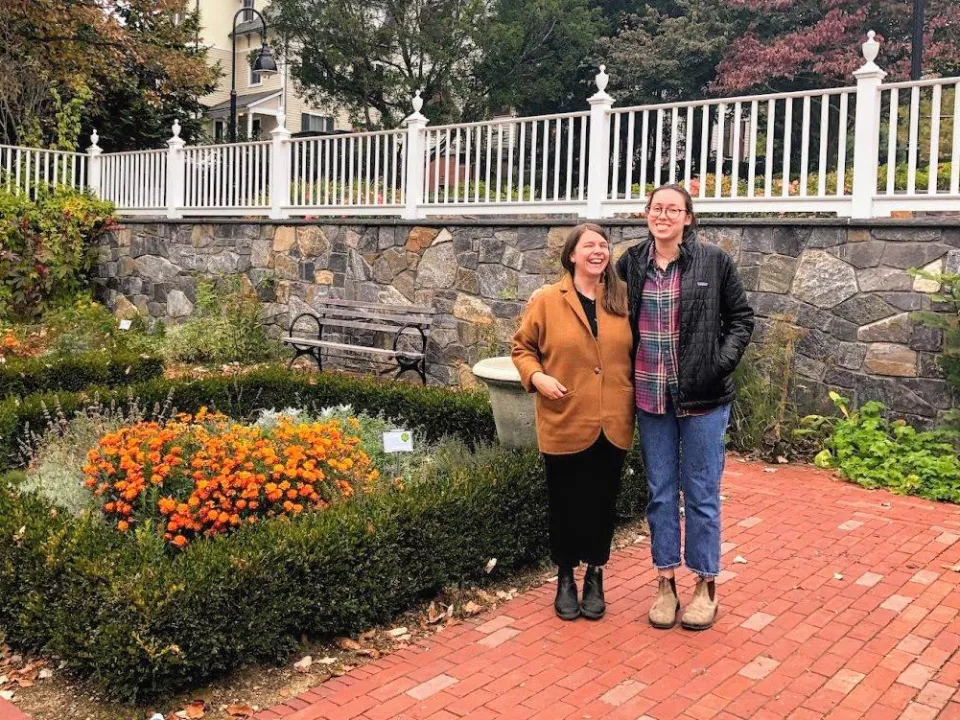Exploring Natural Dye-Making Plants on Campus
Sustainability

Published October 31, 2019
Hannah Asofsky ’21 spent the summer working as an intern at the Smith College Botanic Garden, drawn by her interest in “science communication, and getting people to connect with plants in new and different ways.”
This semester, Asofsky’s work is accomplishing just that, as the foundation for a new exhibit on dyes made from plants on view at the Lyman Plant House. “The Art and Science of Dyeing” explores the world of natural dyes, and aims to connect visitors with dye-making plants in the Happy Chace ’28 Garden and in the Learning Garden behind Northrop-Gillett.
At the start of her project, which she spent this past summer working on, Asofsky asked herself, “How do we accomplish the goals of displaying the dye plants, and highlighting the fact that they are deeply connected to the work that the Botanic Garden does?”
“The Art and Science of Dyeing” aims to get visitors excited about exploring plant life at Smith, says Sarah Loomis, the Botanic Garden’s manager of education. Some visitors may not know that “the Botanic Garden encompasses the entire campus,” Loomis points out. “So, one of our goals is to have the exhibit highlight an outdoor space.”
The Botanic Garden has also collaborated with the Design Thinking Initiative on hosting hands-on dye workshops for students using natural indigo and marigold dyes. The next one will be held on Wednesday, Nov. 6, from 6 p.m. to 8:30 p.m. at Capen Annex.
“The Art and Science of Dyeing” begins inside the Lyman Plant House, where visitors are invited to touch long swaths of hanging fabrics dyed in collaboration with local textile artist Michelle Parrish. “We wanted something interactive and really beautiful that invited people in, and also got them thinking about how plants all around us play many different roles,” Loomis says.
Panels about the history of natural dyes and the plants used to make them are displayed along the walls. An important component of the exhibit are the “lesser told narratives” of how plants connect to our history and economy, Loomis says.
For example, one panel tells the story of Eliza Lucas, a young woman known for bringing the natural dye, indigo, into the southern U.S., where it was developed commercially in the 19th century. The story emphasizes that Lucas’ accomplishments would not have been possible without the contributions of Native Americans and enslaved people from Africa, whose cultural artistry and labor were used in the development of indigo dye.
“You might think of indigo as just this beautiful blue dye, but as you dig, you discover layers of stories that are really important to hold up and tell,” Loomis says.
Loomis and Asofsky hope the new exhibit, which coincides with the college’s Year On Climate Change, will foster greater awareness about where dyes for consumer goods come from.
While “experiencing the Botanic Garden is very meditative and calming,” Asofsky says, the new exhibit also offers visitors the opportunity to “walk away with an understanding of the complexity” of horticulture and its traditional uses.
“The Art and Science of Dyeing” is on view at Lyman Plant House through May 2020.
Sarah Loomis (left), manager of education at the Smith Botanic Garden, and Hannah Asofsky ’21 in the Happy Chace ’28 Garden.